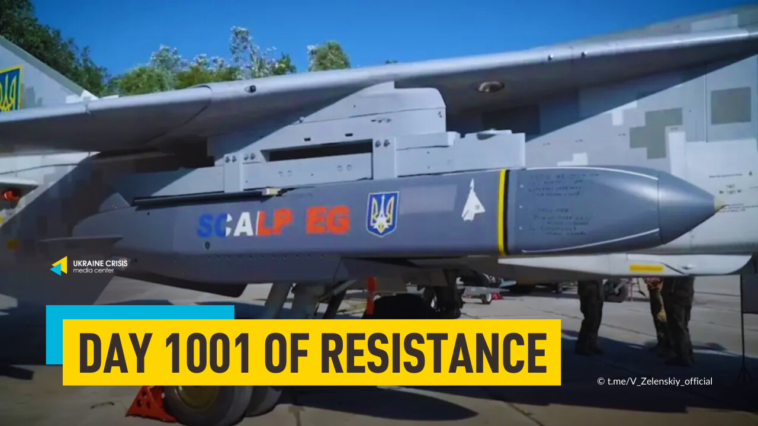The U.S. greenlights Ukraine’s use of British Storm Shadow missiles on targets inside Russia. Ukrainian drones strike a munitions arsenal in Russia’s Novgorod region. Russia’s Black Sea fleet is in the spotlight of a British defence intelligence war update.
U.S. greenlights Ukraine’s use of British Storm Shadow missiles on targets inside Russia
Ukrainian media cited The Times, which reported Wednesday that the U.S. had given go-ahead for Britain’s long-range Storm Shadow missiles to be used by Ukraine to strike deep inside Russia, ending a months-long prohibition, according to UK government sources.
The “turning point”, according to a Foreign Office source, came when Russia drafted North Korean soldiers into the conflict, which was viewed as a “major escalation”.
On Tuesday the British PM argued Ukraine “must have what it needs for as long as it needs”. Still, Starmer refused to set out a definitive position, arguing that going into “operational matters” would have only one winner: Putin.
In August, The Times said Washington was in effect blocking Britain from allowing Kyiv to fire Storm Shadow missiles inside Russia, amid fears in the Biden administration of an escalation in the Ukraine war. The UK reportedly asked the U.S. for the permission, but never got an answer, something the White House denied at the time.
Five former UK defence secretaries and an ex-prime minister have urged Sir Keir Starmer to allow Ukraine to use its long-range Storm Shadow missiles to strike inside Russia — even without U.S. backing, The Times reported in September.
Ukrainian drones strike munitions arsenal in Russia’s Novgorod region
Ukrainian drones struck an ammunition depot in Russia’s Novgorod region overnight on Wednesday, according to Russian media reports.
The depot identified as the 13th arsenal of the Defense Ministry’s Main Missile and Artillery Directorate (GRAU) is located in the town of Kotovo. Footage circulated on social media appears to depict explosions caused by a drone attack.
The regional governor, Andrei Nikitin, wrote about the destruction of several drones over the region, adding there were no casualties. He did not specify if the attack caused any damage.
The Russian defense ministry reported that a total of 44 drones were shot down overnight, including 20 over the Novgorod region. The rest were intercepted over the regions of Kursk, Oryol, Belgorod, Tula, Tver, Bryansk, Smolensk and Moscow.
Kotov is roughly 680 kilometers (approx. 422 miles) from the Russia-Ukraine border. The depot covers an area of nearly three square kilometers (approx. 1.2 square miles), Ukrainian news web site Defense Express said.
Russia’s Black Sea fleet in spotlight of British defence intelligence war update
Ukraine has destroyed or damaged a quarter of the Russian Black Sea fleet since the invasion, pushing back much of the Russian navy from Crimea into the eastern part of the Black Sea and denying Russia control of its western waters, the British Defence Intelligence said in its latest update on Russia’s war in Ukraine.
“Prior to Russia’s invasion of Ukraine in 2022, Russia’s leadership almost certainly perceived the Russian Federation Navy and the Black Sea Fleet as integral components of their strategic maritime power. After 1,000 days of war, Russia’s naval capabilities in the Black Sea have been significantly depleted through highly effective Ukrainian operations,” the report reads.
“Pre-invasion, the Ukrainian Navy was vastly outnumbered by the Black Sea Fleet and limited to a small number of major warships and coastal defence vessels. Throughout the conflict, the Ukrainian Navy has been unable to operate conventionally in the Black Sea. However, since 24 February 2022, Ukrainian forces have destroyed or damaged over 25% of major Russian warships operating in the Black Sea. This includes the sinking of the Black Sea Fleet flagship, Slava-Class cruiser ‘MOSKVA’, which had previously been described as a cutting-edge air defence platform,” the British Defence Intelligence said.
As a result, Russia’s Black Sea Fleet has been forced to move all of its major assets from its historic base in Sevastopol to Novorossiysk in the Eastern Black Sea. Russian units operating in the region have also been forced to adapt their tactics and change the areas in which they operate.
Despite Russia’s Black Sea Fleet currently being limited to the Eastern Black Sea, it retains the ability to conduct long range strikes into Ukraine in support of land operations, the report concludes.
Russia last month suffered its most significant troop losses since the start of the war in Ukraine while making territorial gains, the UK’s Chief of the Defence Staff Tony Radakin said earlier this month. Russian army had “on average over 1,500 people either killed or wounded every single day,” Radakin said in an interview with the BBC.
Russian forces have increased offensive pressure on the city of Kupyansk in Kharkiv region, the UK Defence Intelligence said last week.




